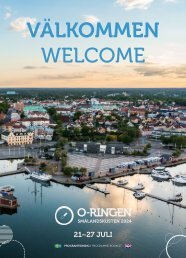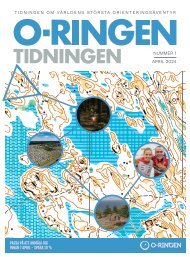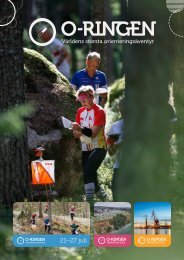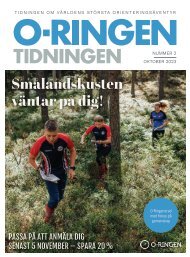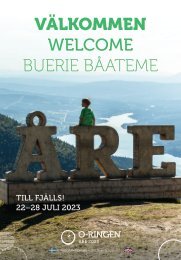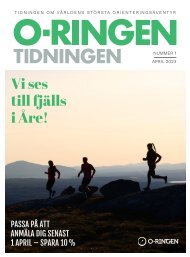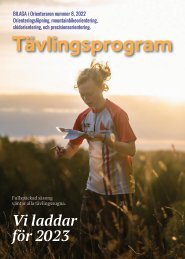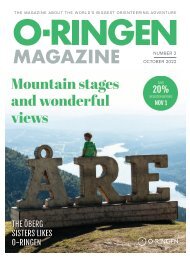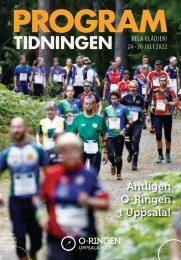O-Ringen Magazine, nr 1 2024
The worlds biggest orienteering adventure. Oskarshamn, Smålandskusten, July 21st to 27 th 2024.
The worlds biggest orienteering adventure. Oskarshamn, Smålandskusten, July 21st to 27 th 2024.
Create successful ePaper yourself
Turn your PDF publications into a flip-book with our unique Google optimized e-Paper software.
TEXT ANDREAS DAVIDSSON FOTO PRIVAT<br />
Lena and Jakob analyse the O-<strong>Ringen</strong> terrain<br />
1<br />
When O-<strong>Ringen</strong> comes to the Småland<br />
Coast, we’ll be visiting terrain that<br />
is unfamiliar for many orienteers in<br />
Sweden. You will be met with fast<br />
running, technical orienteering,<br />
hilltops, detailed maps and a<br />
challenging but fun experience.<br />
We’ve asked two of the very best local orienteers,<br />
former elite runners Jakob Lööf and<br />
Lena Eliasson-Lööf, to analyse the terrain<br />
and maps – so that you can arrive at the<br />
competition as well prepared as possible.<br />
How would you describe the terrain to<br />
someone who hasn’t been here before?<br />
– The first things that come to mind are high<br />
speed and technical orienteering in mostly<br />
open forests. With one or two exceptions,<br />
the terrain is mostly fairly flat,” says Jakob<br />
Lööf, who works as the club development<br />
officer for Västerviks OK, one of the many<br />
organising clubs.<br />
His clubmate, not to mention wife, Lena<br />
Eliasson-Lööf, is quick to elaborate:<br />
– I’d say that visibility is great and you<br />
can cruise along if you get a good line, for<br />
example on the open hilltops. If you manage<br />
to get that kind of line, it’s hard not to smile.<br />
It’s very different to last year’s mountain<br />
terrain, in other words. Maybe even the<br />
exact opposite. The areas nearest the coast<br />
STAGE 1, MODERATE (JAKOB LÖÖF)<br />
As we’ve already talked about, choosing a route is<br />
a lot about how confident you are at reading the<br />
terrain and how well you can follow your compass.<br />
For this leg, the red option simplifies the orienteering<br />
to begin with, using the big marsh and the hill to the<br />
right as clear handrails. The last fifth of the leg is<br />
more challenging, as you need to change direction a<br />
bit and climb to eventually find a distinctive open hill<br />
just before the control. This is also a useful feature for<br />
those choosing other routes. A straighter route means<br />
more focus on compass direction and identifying<br />
“positive” features that stick up or out, i.e. which are<br />
easier to spot and use as confirmation that you’re on<br />
the right track. The blue route makes use of the rock<br />
features in this way, whereas the shortest green route<br />
focuses more on contour features.<br />
are often very detailed, with many small,<br />
complex hills with marshes in between,<br />
making for intensely technical orienteering.<br />
All competitors will be challenged with orienteering<br />
in terrain which often allows high<br />
speed thanks to easy conditions underfoot,<br />
but has complex features. The coastal terrain<br />
is quite different to that of the first two stages,<br />
which take place further inland.<br />
– The inland stages are more like typical<br />
Småland forest and I think people will find<br />
these physically tougher, too, says Lena<br />
Eliasson-Lööf, who grew up in Småland and<br />
is familiar with this terrain.<br />
What are you expecting from<br />
this year’s O-<strong>Ringen</strong> competitions?<br />
– As we know, it’s great terrain with good<br />
maps, which for me is the important thing<br />
about O-<strong>Ringen</strong>. As well as that, many of<br />
the organising clubs, with SOK Viljan at the<br />
helm, are used to putting on big competitions.<br />
So it should be well organised, too. I<br />
think a lot of people who compete will sum<br />
up the week as challenging but fun orienteering,<br />
says Jakob.<br />
Challenging terrain and orienteering<br />
Although the forest is mostly open, it’s<br />
important to remember that there are some<br />
denser areas.<br />
– It will be important to adapt your speed.<br />
We often talk about slowing down to orienteer<br />
accurately but I’d say it’s also important<br />
1<br />
“Your route choice<br />
depends on what<br />
features you feel<br />
confident to read<br />
in the terrain”<br />
to be able to speed up where you can,<br />
explains Jakob.<br />
– If you have your orienteering under control<br />
and execute your route choices using the<br />
features you planned to use, orienteering feels<br />
easy here. If you make a mistake, though, it<br />
can take a while to relocate. Looking around<br />
in the forest and then trying to find what you<br />
see on the map can be a challenge, because<br />
everything looks the same and the contour<br />
features are often small.<br />
– One challenge is not to underestimate<br />
the terrain and get lazy with reading the map.<br />
There’s an art to reading the map more often<br />
to find the easiest and most runnable lines,<br />
rather than just following your compass and<br />
spending more time and energy in tougher<br />
parts of the terrain, adds Lena.<br />
Juniors and recreational runners<br />
O-<strong>Ringen</strong> is above all a mass participation<br />
event and for most people, the important<br />
thing is to get round the five stages as well<br />
as possible. For our younger competitors,<br />
it’s often a case of learning as you go. Each<br />
O-<strong>Ringen</strong> is unique and offers new orienteering<br />
experiences.<br />
Of course, many junior runners have their<br />
own aims for the competitions, but the most<br />
important thing for these groups is to be<br />
successful in Småland.<br />
STAGE 1, DIFFICULT (JAKOB LÖÖF)<br />
A longer leg where the blue option is<br />
safer and flatter along the stream but<br />
uses thicker forest, which could slow<br />
things down a bit. It has a safe approach<br />
to the control, below the two big hills<br />
and across the re-entrant between<br />
them, without having to climb much.<br />
The green option also starts along the<br />
stream but then takes a shorter, straighter<br />
line. There is some extra climb and it’s<br />
trickier technically, especially on the<br />
Is there anything that juniors<br />
in particular should think about?<br />
– It can be difficult to follow paths across<br />
hilltops, and if you’re going to leave a<br />
handrail in a vague area, try to find an exact,<br />
distinctive point to leave it, is Lena Eliasson-Lööf<br />
’s advice.<br />
– The maps are often detailed and it’s not<br />
always easy to tell which features are on<br />
them, continues Jakob.<br />
–You have to simply the orienteering by<br />
looking for really distinctive features, then<br />
take careful bearings between them. If you’d<br />
really like to run well, running a training<br />
course in the few days before the competitions<br />
can help you find out what features you<br />
find easiest to use here. Ask yourself, “What<br />
features are really distinctive here?”<br />
For recreational runners, too, O-<strong>Ringen</strong><br />
is about adapting the orienteering to your<br />
skill level in order to get round each day. If<br />
reading contours isn’t your strong point, it<br />
might be better to go round more on clearer,<br />
“safer” routes.<br />
– Make sure you have a clear plan and<br />
know what to look out for before you leave a<br />
control, advise both Jakob and Lena.<br />
– If it’s difficult to identify a clear point,<br />
you could combine multiple features within<br />
sight of each other.<br />
hilltops, which are flat, with only small<br />
features. The small, open hill is a welcome<br />
reassurance on the way into the control.<br />
Running south of the red line gives a<br />
gentler and easier approach. The start of<br />
the leg is tougher, going over some hills<br />
and through the marsh, however the way<br />
this option then takes you along the flat<br />
bit next to the big hill is tempting. The<br />
safer orienteering on this option lets you<br />
run faster.<br />
Route choices and technical skills<br />
At O-<strong>Ringen</strong> it’s important to make sensible<br />
route choices, both in terms of finding the<br />
controls and making sure you still have<br />
something left for the last stage.<br />
Generally, what should you think about<br />
when choosing routes here?<br />
– With some exceptions on the first two<br />
stages, many people would probably do well<br />
to not think too far from the red line. On<br />
your route, identify which features you are<br />
confident finding in the forest and make<br />
sure you pass them. For example, if you’re<br />
confident reading small contour and marsh<br />
details, your optimum route might not be<br />
much longer than the red line,” says Jakob.<br />
Lena agrees but says running round is fine<br />
if you think you need to. It could be a good<br />
option for anyone who isn’t used to this<br />
kind of terrain, when clearer features and<br />
handrails might be useful.<br />
– Make a plan for the whole leg before<br />
leaving the control. If you run “forwards”<br />
out of the control without planning, you no<br />
longer have the option of a route that starts<br />
by taking you “sideways” or “backwards”.<br />
Make sure you decide where to go, rather<br />
than just ending up somewhere, says Lena.<br />
» About JAKOB AND LENA<br />
Name: Jakob Lööf<br />
Age: 38<br />
Family: Wife Lena Eliasson-Lööf and sons<br />
Hampus and Kasper Lööf.<br />
Occupation: Club development officer at<br />
Västerviks OK.<br />
First club: Pan-Kristianstad<br />
Biggest orienteering achievement: Changing<br />
over in the lead after the long night leg at<br />
10Mila 2008<br />
Best memory from O-<strong>Ringen</strong>:<br />
The atmosphere at the elite sprint at Boden<br />
2013, where I was 3 rd , with thousands of<br />
spectators along the course and in the<br />
finish arena.<br />
Best advice for O-<strong>Ringen</strong>: Pack your swimming<br />
costumes and remember to enjoy the<br />
great orienteering.<br />
Name: Lena Eliasson-Lööf<br />
Age: Turning 43 during O-<strong>Ringen</strong><br />
Family: Husband Jakob Lööf and sons<br />
Hampus and Kasper Lööf<br />
Occupation: Home Economics teacher for<br />
ages 6-9 years<br />
First club: Nässjö OK<br />
Orienteering background: International runner<br />
from 2005-2016, with several WOC and EOC<br />
medals. Three 10Mila wins with Domnarvets<br />
GoIF.<br />
Biggest orienteering achievement: Difficult to<br />
say, but possibly 10Mila 2008 in Rosersberg<br />
was the most impressive. Sadly I don’t think I<br />
understood how well I ran at the time – I had<br />
a stroke shortly afterwards so I never really<br />
had time to reflect on the achievement.<br />
32 O-RINGEN MAGAZINE NO. 1 • <strong>2024</strong> O-RINGEN MAGAZINE NO. 1 • <strong>2024</strong> 33



